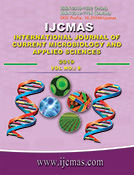


 National Academy of Agricultural Sciences (NAAS)
National Academy of Agricultural Sciences (NAAS)

|
PRINT ISSN : 2319-7692
Online ISSN : 2319-7706 Issues : 12 per year Publisher : Excellent Publishers Email : editorijcmas@gmail.com / submit@ijcmas.com Editor-in-chief: Dr.M.Prakash Index Copernicus ICV 2018: 95.39 NAAS RATING 2020: 5.38 |
The sandal spike disease is becoming serious threat to sandal cultivation in the southern states viz., Karnataka, Tamilnadu and Kerala. The high price of Sandal wood declared by the government of Karnataka and liberalization for the private cultivation of Sandal by valid license from the forestry department has encouraged the farmers to go for planting of Sandal on even very fertile soils. A number of Sandal plantations have also come up Karnataka. The disease incidence and prevalence in farmer’s sandal plantations was assessed by using complete enumeration method. 24 sandal plantations were surveyed from five districts in Southern Karnataka, the incidence of sandal spike disease. The disease incidence was ranged from 0 to 18 per cent. The maximum incidence of 18 per cent was recorded in Sira taluk of Tumkur district, followed by Shimoga, 1.65 per cent. The least incidence of 0.33 per cent was recorded in plantations of Tygarthi village. However, the plantations of Chickballapur, Chickmagalore and Chitradurga were free from incidence of spike disease. The presence of spike disease was confirmed by PCR technique using phytoplasma specific primers. Cross transmission studies between Sandal spike and Stachytarpheta phyllody through Dodder (Cuscuta subinclusa) revealed that, spike phytoplasma could not be transmitted to any of the inoculated Stachytarpheta plants, indicating the inability of phytoplasma to infect and establish in the host. The PCR analysis of all dodder inoculated Stachytarpheta plants for the spike phytoplasma also gave negative results and there is no inter-relation between Sandal and Stachytarpheta for transmission of Phytoplasama.
 |
 |
 |
 |
 |